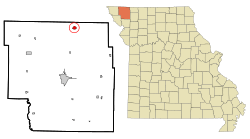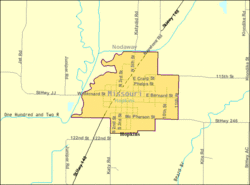Hopkins, Missouri facts for kids
Quick facts for kids
Hopkins, Missouri
|
|
|---|---|

Location of Hopkins, Missouri
|
|

U.S. Census Map
|
|
| Country | United States |
| State | Missouri |
| County | Nodaway |
| Township | Hopkins |
| Area | |
| • Total | 0.71 sq mi (1.85 km2) |
| • Land | 0.71 sq mi (1.85 km2) |
| • Water | 0.00 sq mi (0.00 km2) |
| Elevation | 1,053 ft (321 m) |
| Population
(2020)
|
|
| • Total | 472 |
| • Density | 661.99/sq mi (255.46/km2) |
| Time zone | UTC-6 (Central (CST)) |
| • Summer (DST) | UTC-5 (CDT) |
| ZIP code |
64461
|
| Area code(s) | 660 |
| FIPS code | 29-33004 |
| GNIS feature ID | 2394418 |
Hopkins is a small city located in northern Nodaway County, Missouri, in the United States. In 2020, about 472 people lived there, making it the third largest city in the county.
Contents
History of Hopkins, Missouri
Hopkins was founded in 1870. It was named after A.L. Hopkins, who worked for a railroad company. The railroad tracks were removed in 1983. A post office has been open in Hopkins since 1871.
Did you know that Grant Wallace, a writer interested in mysterious topics, was born in Hopkins in 1867?
The Hopkins Tornado of 1881
In 1881, a very strong tornado hit Hopkins. It is thought to be one of the first F5 tornadoes ever recorded. An F5 tornado is the strongest type of tornado.
Federal Aid After the 1952 Tornado
On November 16, 1952, a tornado caused a lot of damage to the downtown area of Hopkins. Mary Jane Truman, who was the sister of President Harry S Truman, had visited the town a year before. She contacted her brother, and Hopkins became the first town in the United States with fewer than 1,000 people to get help from the government after a disaster.
The government sent $10,000 to help the town. A local businessman named Wren Peve managed the money carefully. After everything was fixed, there was some money left over. Mr. Peve sent the extra money back to Washington, D.C. The cleanup was led by Landon Wallace, who was also the Hopkins Fire Chief.
Rancho del Rayo: A Large Ranch
In the early 1900s, a huge ranch called Rancho del Rayo was located near Hopkins. It was at least 3,900 acres large. This ranch was known for having the biggest herd of hereford cattle in Missouri.
World War II and Other Conflicts
During World War II, Hopkins was a small town with less than 1,000 people. Sadly, fourteen men from Hopkins died during the war. This included two brothers, Charles and George Russell, who passed away in April 1945, just one day apart. Charles drowned in the Pacific Ocean, and George was accidentally shot in Germany. Carl Melvin was on the USS Indianapolis when it sank. Charles Pistole died at Tarawa while operating a landing craft.
In other wars, Glenn Ulmer died in World War I. The local American Legion Post is named in his honor. Gary Cross died in the Vietnam War. Hopkins did not lose any residents in the Korean War.
Hopkins Picnic Tradition
Every year, the town of Hopkins celebrates the Hopkins Picnic. This fun event takes place on the second weekend in July. It has been a yearly tradition since 1888!
Geography and Location
Hopkins is located where Missouri routes 148 and 246 meet. It is about two miles south of the border between Missouri and Iowa. Maryville is about 14 miles south, and Pickering is halfway between Hopkins and Maryville. Bedford, Iowa is about nine miles northeast.
The East Fork of the One Hundred and Two River flows past the north and west sides of Hopkins. It joins with the West Fork to form the One Hundred and Two River about three miles southwest of the city.
According to the United States Census Bureau, Hopkins covers a total area of about 0.72 square miles (1.85 square kilometers), and all of it is land.
Population and People
| Historical population | |||
|---|---|---|---|
| Census | Pop. | %± | |
| 1880 | 920 | — | |
| 1890 | 846 | −8.0% | |
| 1900 | 907 | 7.2% | |
| 1910 | 909 | 0.2% | |
| 1920 | 918 | 1.0% | |
| 1930 | 815 | −11.2% | |
| 1940 | 834 | 2.3% | |
| 1950 | 825 | −1.1% | |
| 1960 | 710 | −13.9% | |
| 1970 | 656 | −7.6% | |
| 1980 | 634 | −3.4% | |
| 1990 | 575 | −9.3% | |
| 2000 | 579 | 0.7% | |
| 2010 | 532 | −8.1% | |
| 2020 | 472 | −11.3% | |
| U.S. Decennial Census | |||
Hopkins Population in 2010
In 2010, there were 532 people living in Hopkins. These people lived in 219 households, and 146 of these were families. The city had about 739 people per square mile.
Most of the people living in Hopkins were White (97.6%). A small number were African American (1.7%) or Asian (0.4%). About 0.8% of the population was Hispanic or Latino.
In 2010, about 33% of households had children under 18 living with them. About 51% were married couples living together. The average household had 2.43 people, and the average family had 3.03 people.
The average age of people in Hopkins was 35.6 years old. About 28% of residents were under 18. About 15% were 65 years old or older. The population was almost evenly split between males (48.7%) and females (51.3%).
Notable Person from Hopkins
- George Hayford, an attorney
See also
 In Spanish: Hopkins (Misuri) para niños
In Spanish: Hopkins (Misuri) para niños

